Early six-coupled tank engines produced by the Great Western railway varied considerably in design from lot to lot. The complex history is meticulously chronicled by Jim Russell in his book [reference 1]. All of these locomotives were provided with saddle tanks and many were outside-framed.
At least one G.W.R. inside-framed saddle tank of the period survives - '813' which is described in more detail below.
Introduction of pannier tanks
From 1911 onwards, as these saddle tank locomotives entered the works for heavy repair, pannier tanks progressively replaced the saddle tanks. The pannier tank is an ingenious way of solving the problem of storing water on locomotives without a separate tender. I discussed this in the post Water, water, everywhere.
Collett's '57XX' class
The ubiquitous 'Pannier Tank' with 4 ft. 7.5 in. diameter wheels which I remember from the steam era was introduced by Collett in 1929, as a replacement for the elderly stock of 'Pannier Tanks'. The initial build as the '57XX' class was based on the earlier '27XX' class after rebuilding with pannier tanks. When the last batch of 'Pannier Tanks' was built in 1950, 'Pannier Tanks' (including variations) totalled 863 locomotives.

Whilst the leading and driving axles had leaf springs, the trailing axle had a dual coil springs on each wheel, which stood up into the cab, making the fireman's job a little harder.
The Great Western didn't build all the 'Panniers' itself and batches were sub-contracted to private builders. For instance, Birmingham Railway Museum's Pannier Tanks 7752 and 7760 (shown below) were both built by North British Locomotive Company Limited in 1930. There's a short article on North British here.
Preserved 'Pannier' 7752 at Tyseley (Photo: Birmingham Railway Museum).
The design survived because of its practicality. Although officially designated as a 'light goods and shunting engine', they were very versatile - my friend John frequently makes fun of me for my off-the-cuff remark once when being interviewed for a railway video that "You can do anything with a Pannier".
There's a detailed history of the '57XX' class on Wikipedia here and in the Great Western Archive pages Introduction and Details of Allocation.
Collett's '54XX'/'64XX'/'74XX' classes
In 1932, 'Pannier Tanks' with 5 ft. 2 in. diameter wheels, 165 p.s.i. boilers and fitted for 'Auto Train' working were introduced, as a replacement for similar elderly locomotives. The '54xx' class had 25 members. A further batch of 40 locomotives, also 'Auto' fitted, were produced with 4 ft. 7.5 in. diameter wheels, forming the '64XX' sub-group. Finally, between 1936 and 1950, 50 locomotives of the '74XX' group were constructed with boilers uprated to 180 p.s.i. but not 'Auto' fitted.
There's further information on the '54XX' class and the sub-classes in Wikipedia here and in the Great Western Archive pages Introduction and Details of Allocation.
6412, 6430 and 6435 have been preserved.
Collett's '1366' class
In 1934, six 'Pannier Tanks' with 3 ft. 8 in. diameter wheels and outside cylinders were built to replace life-expired types for dock and similar shunting.
There's further information on the '1366' class in Wikipedia here and in the Great Western Archive pages Introduction and Details of Allocation.
1369 has been preserved and there is a detailed history of this locomotive here.
Hawksworth's '94XX' class
The story goes that the Chairman of the G.W.R. Sir James Milne (1883-1958) had decided that a more modern design of locomotive was required for bringing empty coaching stock into Paddington to promote the proper corporate image to passengers as they joined their train. Certainly, Collett's '57XX' locomotives then in use, with a large dome and cast chimney appeared to be from an earlier era.
Accordingly, Frederick Hawksworth, the Chief Mechanical Engineer, was tasked with producing a suitable design. Hawksworth used the cylinder design and boiler from Collett's successful 2251 class. Swindon Standard Boiler Number 10 was a tapered, domeless Belpaire boiler pressed to 200 p.s.i. with a sloping grate of 17.4 square feet area.
I love the story but don't know if it's true. Certainly, James Milne was opposed to nationalisation of the railways and, when the G.W.R. was nationalised after World War II, he declined the offer of the chairmanship of the Railway Executive of the British Transport Commission which would run the nationalised railways, instead taking retirement.
Swindon managed to produce the first ten '94XX' locomotives prior to Nationalisation in 1948. In the post The End of an Era I talked about the Nationalisation of the railways in Britain in 1948 and the subsequent building of 999 steam locomotives of various modern designs, intended to help to unify the former 'Big Four' railways into a single unit. However, in what may be seen as a final act of defiance, the Great Western Railway placed an order with private contractors for 200 more of the '94XX' class, leaving British Railways to pick up the bill.
There's more about the '94XX' class in Wikipedia here and in the Great Western Archive Introduction and Details of Allocation.
Hawksworth's '15XX' class
This was a remarkable Hawksworth design to conclude the 'Pannier Tank' story. It adopted some of the '94XX' design and used the same Swindon Standard Boiler Number 10 but featured a short wheelbase, two outside cylinders and Walschaerts motion! Ten were built at Swindon, post-nationalisation, in 1949 and all had a short working life. '1501' is preserved.
There's more about the '15XX' class in Wikipedia here and in the Great Western Archive Introduction and Details of Allocation.
Hawksworth's '16XX' class
Between 1949 and 1955. 70 off of this 'Pannier Tank' were built at Swindon. With 4 ft 1.5 in diameter coupled wheels and height kept to an minimum, they could work on routes with low clearances but their working life was short. One locomotive,'1638', was preserved.
Wikipedia has details here and the Great Western Archive pages has information on Introduction and Details of Allocation.
Saddle Tank '813'
'813' was not actually G.W.R.-built. She was built by Hudswell Clark in 1901 for the Port Talbot Railway and Docks Company. The G.W.R. operated this line for the Port Talbot company from 1908 and finally absorbed the company in 1922. This locomotive served the G.W.R. for some years (acquiring various 'Swindon' features) before finally being sold off in 1934. There's a more detailed history of this interesting survivor on the GWR 813 Preservation Fund website here.
When this locomotive visited The Battlefield Line in 2007, I had a couple of enjoyable days driving her. There's a brief report here. The rather lop-sided headboard 'Greendale Express' visible in the picture below was carried during a 'Postman Pat' weekend. If you know as little about Postman Pat as I do, the Wikipedia article here is a useful primer.
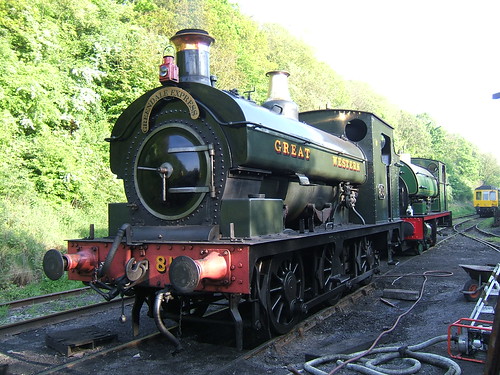 '813' being prepared at Shackerstone on 5th May 2007.
'813' being prepared at Shackerstone on 5th May 2007.
I've worked on six preserved 'Pannier Tanks', listed below:-
7752
I've driven this 'Pannier' many times, on passenger trains, demonstration freight trains and supervising Driving Experience Courses at three locations: Birmingham Railway Museum (as it was then), the Battlefield Line and the Avon Valley Railway. She's always been in green Great Western Railway livery.
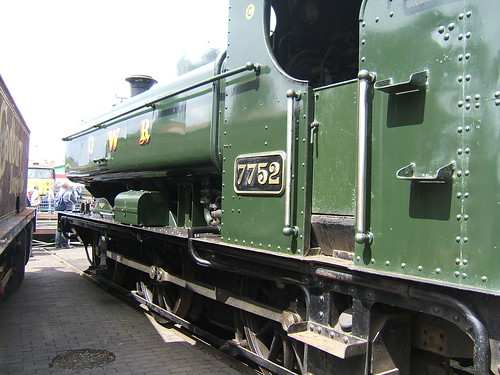 7752 displayed on the Turntable at 'Tyseley 100'.
7752 displayed on the Turntable at 'Tyseley 100'.There's a detailed history of this locomotive on the Tyseley Locomotive Works website here.
7760
I've driven this 'Pannier' many times, on passenger trains, demonstration freight trains and supervising Driving Experience Courses at both Birmingham Railway Museum (as it was then) and the Battlefield Line. The locomotive has been in both green Great Western Railway livery and red London Transport livery (as L90).
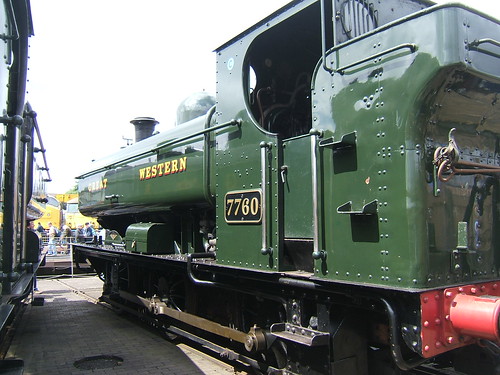 7760 displayed on the Turntable at 'Tyseley 100'.
7760 displayed on the Turntable at 'Tyseley 100'.
There's a detailed history of this locomotive on the Tyseley Locomotive Works website here.
9600
Built 1945 at Swindon in the final form with enlarged cab and larger, rectangular spectacles. I've driven this 'Pannier' a number of times at Birmingham Railway Museum (as it was then), always in British Railways lined black livery .
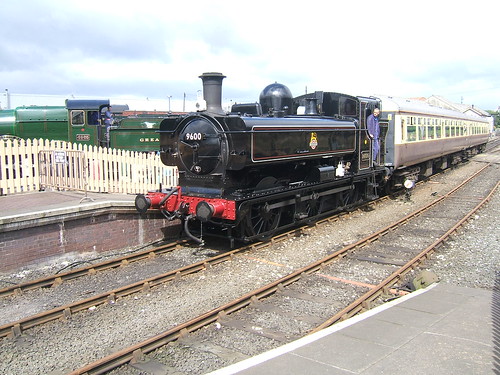 9600 on a passenger train at 'Tyseley 100'.
9600 on a passenger train at 'Tyseley 100'.There's a detailed history of this locomotive on the Tyseley Locomotive Works website here.
5764
I've worked on this locomotive once, when I was invited fire a round trip on the Severn Valley Railway - I think it was in 2004. I believe she was withdrawn from traffic in 2011 and is currently in store awaiting restoration.
5764 at Bewdley in 2008 (Photo: Peter Broster via Creative Commons).
5786
I've enjoyed one day driving this 'Pannier' in October 2010 at the Battlefield Line. I think the unlined black livery with the early totem suits the locomotive (not so sure about the face for 'Day out with Thomas'). This locomotive was preserved by the Worcester Locomotive Society in 1969 and there's more information on the South Devon Railway Association site here.
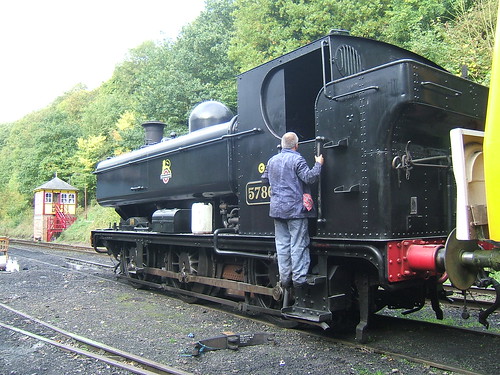 5786 being prepared for duty at Shackerstone in October 2010.
5786 being prepared for duty at Shackerstone in October 2010.
9466
I've driven this 'Pannier' a number of times, always in green Great Western Railway livery, on passenger trains at the Battlefield Line. green at the Battlefield Line. I think the last time was in 2008. This locomotive was built by R. Stephenson in 1952 as their works number 7617 (so the G.W.R. livery is historically incorrect). This engine is kept in immaculate condition, is fitted with a speedometer, AWS/TPWS and an OTMR (Automatic Warning System, Train Protection and Warning System, On Train Monitoring Recorder) and is approved for running on the National Rail Network.
Although they were certainly capable engines, most of the former British Railways enginemen I've spoken to still preferred the earlier Collett '5700' design. One particular problem drivers complained about was that because the design used the '2251' boiler and wider cab, the driver's brake valve ended up too far 'inboard' for the driver to operate it conveniently when leaning out whilst closing up to vehicles. This was fixed with an official brake valve extension link, placing the handle closer to the side of the cab.

Cab view of 9466: The brake valve, with a large copper pipe descending through the floor, is hidden by the regulator handle. A curved link connects the valve to a separate brake lever provided with a turned wooden handle towards the right.
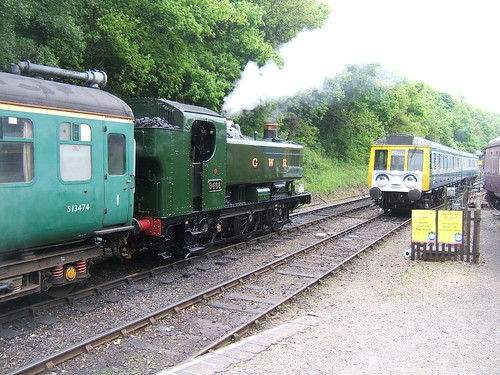 The Battlefield Line, May 2008: '9466' waits to depart from Shackerstone as the DMU (with a face for 'Day out with Thomas') arrives.
The Battlefield Line, May 2008: '9466' waits to depart from Shackerstone as the DMU (with a face for 'Day out with Thomas') arrives.There is an album of pictures showing the construction of this locomotive at portrait at Portrait of a Pannier'.
References
[ 1] ‘A Pictorial Record of Great Western Engines’ by J. H. Russell (Oxford Publishing Company Vol. 1 & 2 1975: reprinted as one volume 1978) SBN 0 86093 02 6.

